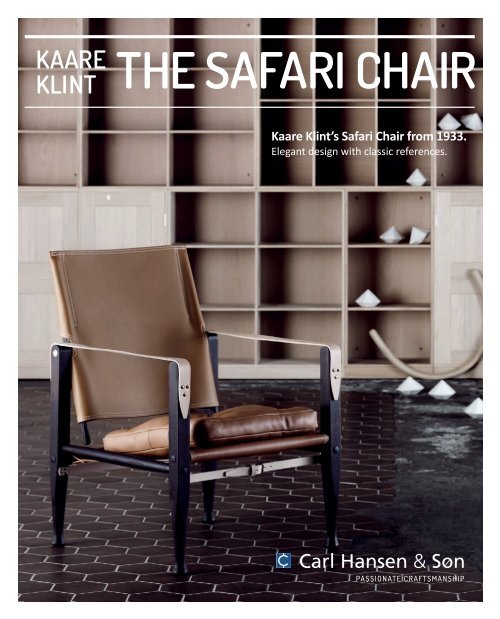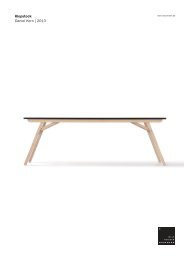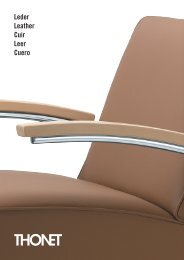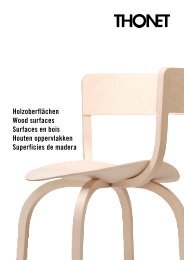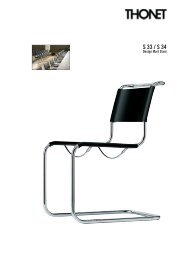THE SAFARI CHAIR
Create successful ePaper yourself
Turn your PDF publications into a flip-book with our unique Google optimized e-Paper software.
kAARE<br />
klint<br />
<strong>THE</strong> <strong>SAFARI</strong> <strong>CHAIR</strong><br />
Kaare Klint’s Safari Chair from 1933.<br />
Elegant design with classic references.
EVERY pIECE<br />
ComES wITH<br />
A SToRY<br />
When you choose a piece of furniture from Carl Hansen & Søn, you<br />
are bringing a story into your home. Each and every piece of our<br />
furniture has a story to tell: About the furniture designer’s unique<br />
design. About the materials and how they are processed. And<br />
about the craftsmanship mastered by Carl Hansen & Søn for over<br />
a century. Craftsmanship is our contribution to the story. We hope<br />
that you will pass on the story. This is why we produce furniture.
kAARE klInT<br />
<strong>THE</strong> FA<strong>THE</strong>R oF moDERn FuRnITuRE ART<br />
Kaare Klint is often called the father of modern furniture art.<br />
He founded the School of Design at the Royal Danish Academy of<br />
Fine Arts (Kunstakademiets Møbelskole) and showed the way<br />
for a number of Denmark’s leading designers, for example<br />
Hans. J. Wegner.<br />
Klint’s central idea was that furniture should serve a purpose<br />
and not dominate the room. Furniture is an instrument for<br />
the body rather than just decoration. His choice of materials<br />
was very central. He gladly renounced pure traditions, but<br />
built upon classical furniture art, which he simplified without<br />
compromising either design or quality. The classical references<br />
can be seen in a number of his most famous pieces of furniture,<br />
for example the Safari Chair from 1933. Klint was a professor at<br />
the Royal Danish Academy of Fine Arts until his death and over the<br />
course of his career received honours including the Eckersberg<br />
Medal in 1928 and the C.F. Hansen Medal in 1954.
<strong>THE</strong> <strong>SAFARI</strong> <strong>CHAIR</strong>. Danish furniture design<br />
with inspiration from warmer climes<br />
Kaare Klint’s Safari Chair is from 1933. Klint designed the chair<br />
with inspiration from an English office chair that he had seen in<br />
images from Africa. Klint was particularly fascinated by a photograph<br />
that showed an author of a travel guide sitting with his wife<br />
in a tent in a savannah.<br />
The Safari Chair features an elegant design and is both light and very<br />
functional. It consists of 11 components, which can be detached and<br />
assembled without the use of tools. And since the chair is also assembled<br />
without the use of adhesive, it is very flexible in relation to<br />
the surface on which it is standing. Regardless of whether this is<br />
a savannah or a living room floor.<br />
Safari Chair in smoked ash and leather, design Kaare Klint.<br />
Bookcase in oak/oil, design Mogens Koch.
Safari Chair in smoked ash and leather,<br />
design Kaare Klint.<br />
Safaristolen er en smuk, let og transportabel hvilestol,<br />
som kan skilles og samles helt uden brug af værktøj.
Safari Chair in ash/oil and canvas, design Kaare Klint<br />
Bookcase in oak/oil, design Mogens Koch.<br />
Opala table lamp, design Hans J. Wegner.
<strong>SAFARI</strong> <strong>CHAIR</strong><br />
design:<br />
KAARE KLINT. 1933<br />
The Safari Chair is available in oil-treated ash, either light or<br />
smoked. The upholstery for the chair and cushion is available in<br />
canvas (natural, green, brown and blue) and leather in selected<br />
Chair<br />
colours. The cushion that comes with the chair is available with or<br />
without buttons. The foot stool is available in the same materials<br />
as the chair.<br />
Foot stool<br />
34<br />
34<br />
80<br />
57<br />
57<br />
57 57
www.carlhansen.com


